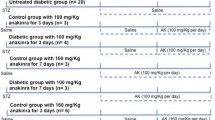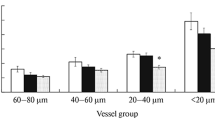Abstract
This work was designed to determine in vivo the influence of the metabolic control of streptozotocin-induced diabetic rats, measured by the levels of haemoglobin glycosylation in blood (HbA1c), on developing vascular endothelial dysfunction. For this, the vasoactive responses to basal and stimulated endothelial nitric oxide (NO) were studied using the technique of the anaesthetized autoperfused rat, analyzing the responses to acetylcholine (ACh) and NG-nitro-l-arginine methyl ester (l-NAME) in non-diabetic and diabetic rats with different degrees of metabolic control (four groups with HbA1c levels of 5.5–7.4%, 7.5–9.4%, 9.5–12%, and >12%, respectively). When administered over a noradrenaline-induced vasopressor tone, ACh (0.25, 0.75, 2.5, 7.5 and 25 µg kg-1) induced dose-dependent vasodilatatory responses in all rat groups, reducing both mean arterial pressure and perfusion pressure of the left hindlimb. These responses were similar in non-diabetic and in diabetic rats with good metabolic control (HbA1c 5.5–7.4%), while diabetic rats with levels of HbA1c higher than 7.5% showed significantly lower vasodilatatory responses to ACh. In untreated diabetic rats, the relaxant responses evoked by the NO donor sodium nitroprusside were also impaired. On the other hand, increasing doses of l-NAME (0.1 to 10 mg kg-1) enhanced both mean arterial pressure and left hindlimb perfusion pressure in diabetic and non-diabetic rats. As with ACh, the responses to l-NAME were significantly reduced in diabetic rats with HbA1c levels higher than 7.5%. To determine the mechanism underlying the NO-mediated endothelial dysfunction, the responses to ACh in untreated diabetic rats (HbA1c >12%) were studied in the presence of the NO substrate l-arginine, in the presence of the oxygen-derived free radical scavenger superoxide dismutase (SOD), or in the presence of both compounds. Both l-arginine and SOD produced a partial improvement of the ACh-induced vasodilatatory responses, but the effects of these agents were not additive. In this group of animals, SOD also induced a partial recovery of the l-NAME-evoked vasoconstrictions. In non-diabetic and untreated diabetic rats, the plasma levels of NO derivatives and arginine were measured. No significant differences were obtained in the amount of nitrites plus nitrates, while plasma levels of arginine were markedly reduced in the untreated diabetic animals. The results indicate that the endothelial dysfunction associated to diabetes is closely related to the level of metabolic control of the disease. Therefore, it is possible to establish a threshold for developing endothelium impairment from percentages of HbA1c higher than 7.5%. As the responses to the NO synthase blocker l-NAME were analogously impaired, it is reasonable to suggest that diabetic endothelial dysfunction is related to the interference with mechanisms linked both to stimulated and basal production of NO. We suggest that this interference is partially due to a deficit in the substrate availability for NO and to an increased generation of superoxide anions.
Similar content being viewed by others
Author information
Authors and Affiliations
Additional information
Received: 22 December 1997 / Accepted: 20 July 1998
Rights and permissions
About this article
Cite this article
Angulo, J., Rodríguez-Mañas, L., Peiró, C. et al. Impairment of nitric oxide-mediated relaxations in anaesthetized autoperfused streptozotocin-induced diabetic rats. Naunyn-Schmiedeberg's Arch Pharmacol 358, 529–537 (1998). https://doi.org/10.1007/PL00005289
Issue Date:
DOI: https://doi.org/10.1007/PL00005289




